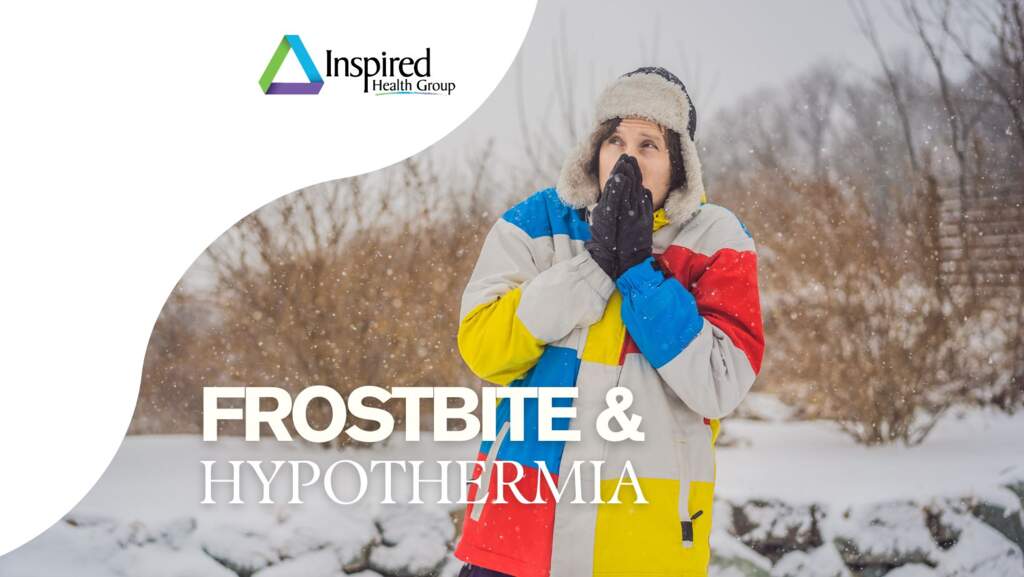Jan 8, 2025
What to do if you notice the signs of Frostbite or Hypothermia
What is frostbite?
Frostbite is a type of injury caused by freezing. It typical occurs in extremities such as the nose, ears, cheeks, chin, fingers, and toes, and leads to a loss leads to a loss of feeling and color in the affected areas. Frostbite can permanently damage the body. Severe frostbite can lead to amputation, removing the affected body part.
Who’s most at risk?
You may have a greater chance of developing frostbite if you
- have poor blood circulation
- are not properly dressed for extremely cold temperatures
What are the signs and symptoms of frostbite?
If you notice redness or pain in any skin area frostbite may be beginning. Get out of the cold or protect any exposed skin. Any of the following signs may point to frostbite:
- A white or grayish-yellow skin area
- Skin that feels unusually firm or waxy
- Numbness
- A person who has frostbite may not know they have it until someone else points it out because the frozen parts of their body are numb.
How to treat frostbite if you notice the signs and symptoms in yourself or someone else:
If you notice signs of frostbite on yourself or someone else, seek medical care, if possible. Check to see if the person is also showing signs of hypothermia. Hypothermia is a more serious condition and requires emergency medical care.
If (1) a person shows signs of frostbite, but no signs of hypothermia and (2) immediate medical care is not available, do the following:
- Get the person into a warm room as soon as possible.
- Unless absolutely necessary, do not walk on feet or toes that show signs of frostbite. Doing so increases the damage.
- Do not rub the frostbitten area with snow or massage it at all. This can cause more damage.
- Put the areas affected by frostbite in warm—not hot—water (the temperature should be comfortable to the touch for unaffected parts of the body).
- If warm water is not available, warm the affected area using body heat. For example, you can use the heat of an armpit to warm frostbitten fingers.
- Do not use a heating pad, heat lamp, or the heat of a stove, fireplace, or radiator for warming. Affected areas are numb and can easily burn.
- Don’t substitute these steps for proper medical care. Frostbite should be checked by a health care provider. And remember, Hypothermia is a medical emergency and immediate medical care is necessary.
What is hypothermia?
Hypothermia is a medical emergency in which your body is loosing heat faster than it can produce heat, causing a dangerously low body temperature. It is caused by prolonged exposures to very cold temperatures. Body temperature that is too low affects the brain, making the victim unable to think clearly or move well. This makes hypothermia especially dangerous, because a person may not know that it’s happening and won’t be able to do anything about it.
While hypothermia is most likely at very cold temperatures, it can occur even at cool temperatures (above 40°F) if a person becomes chilled from rain, sweat, or submersion in cold water.
Who’s most at risk?
Victims of hypothermia are often:
- Older adults with inadequate food, clothing, or heating
- Babies sleeping in cold bedrooms
- People who remain outdoors for long periods—the homeless, hikers, hunters, etc.
- People who drink alcohol or use illicit drugs.
What are the signs and symptoms of hypothermia?
The following are warnings signs of hypothermia:
Adults:
- Shivering
- Exhaustion or feeling very tired
- Confusion
- Fumbling hands
- Memory loss
- Slurred speech
- Drowsiness
Babies:
- bright red, cold skin
- very low energy
What to do or you or someone else as signs of hypothermia:
Hypothermia is a medical emergency. If you notice any of the above signs, take the person’s temperature. If it is below 95° F, get medical attention immediately!
If you are not able to get medical help right away, try to warm the person up.
- Get the person into a warm room or shelter.
- Remove any wet clothing the person is wearing.
- Warm the center of the person’s body (chest, neck, head, and groin) using blankets. If available, us an electric blanket. You can also use skin-to-skin contact under loose, dry layers of blankets, clothing, towels, or sheets.
- Warm drinks can help increase body temperature, but do not give alcoholic drinks. Do not give beverages to an unconscious person.
- After body temperature has increased, keep the person dry and wrap their body, including their head and neck, in a warm blanket.
- Get the person proper medical attention as soon as possible.
- A person with severe hypothermia may be unconscious and may not seem to have a pulse or to be breathing. In this case, handle the person gently, and get emergency assistance immediately.
- Perform CPR, even if the person appears dead. CPR should continue until the person responds or medical aid becomes available. Keep warming the person while performing CPR. In some cases, hypothermia victims who appear to be dead can be successfully resuscitated.
Learn more about Frostbite and Hypothermia from the Centers of Disease Control and Prevention
Prevent frostbite & hypothermia by dressing appropriately:
Signs, symptoms and images of frostbite:
Related Blogs:
